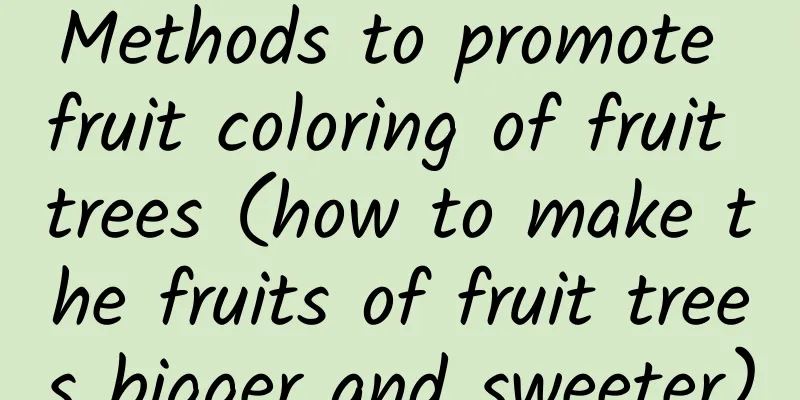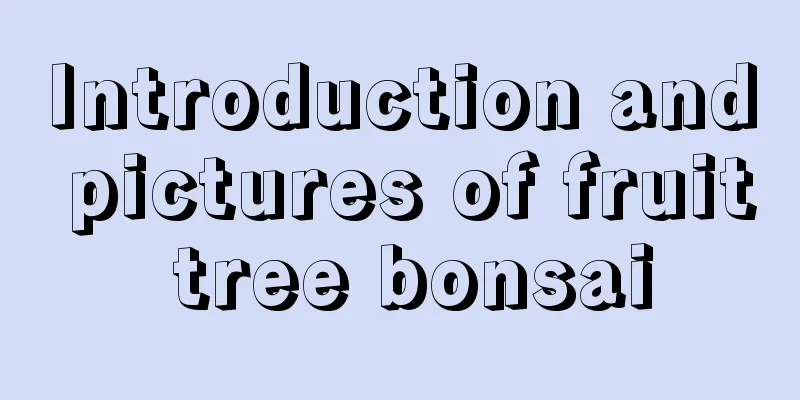Methods to promote fruit coloring of fruit trees (how to make the fruits of fruit trees bigger and sweeter)

How to make fruit trees bear big and sweet fruitsIf you want the fruits of fruit trees to be bigger, sweeter and more colorful, you need to do three things well: scientific fertilization, reasonable pruning, and disease and insect prevention. Scientific fertilizationFruit trees need the help of fertilizers from planting to fruit swelling and picking, but how should they be fertilized? There is a saying among the people: "Nitrogen" grows leaves, "Phosphorus" grows fruits, and insufficient "Potassium" grows firewood. Therefore, nitrogen, phosphorus and potassium are essential nutrient components in the growth process of fruit trees, among which phosphorus and potassium are particularly important during the fruit swelling period. The demand for nitrogen is the highest before and during flowering, and the demand for phosphorus is the highest from inflorescence separation to flowering. The demand for potassium continues throughout the growth period, especially from inflorescence separation to berry ripening. The early differentiation of flower buds in fruit trees basically relies on the nutrients accumulated in the branches and trunks in the previous year. It is difficult for weak branches to have a good yield. Therefore, fertilization must be scientifically proportioned, and potassium fertilizer must be supplemented in a timely manner, and must be supplemented quickly during the critical period of crop growth. Reasonable pruningPruning fruit trees is a task that many growers may overlook, especially those who are new to fruit tree planting. Looking at the thriving fruit trees, how can they bear to prune and remove the fruits? The reason for pruning is to prevent the fruit trees from growing too fast, because the number of fruits a tree can bear is limited. If a large amount of nutrients is supplied to the growth of leaves and branches, there will not be enough nutrients to make the fruit swell and change color, and the final fruit quality will definitely be reduced. In addition, proper pruning of fruit trees can also promote ventilation and light between fruit trees, which is very helpful for leaf photosynthesis and increasing the sweetness of the fruit. Pest and disease controlFruit trees are easily attacked by diseases and pests during their growth. Once they appear, they will directly affect the quality and yield of the fruit. Therefore, we must also pay attention to the prevention and control of diseases and pests during daily planting. On the one hand, we need to do a good job of cleaning up the park to reduce the spread of pathogens. It should be noted that many overwintering pathogens live in fallen leaves and branches, and will begin to spread when the right environment appears. On the other hand, improving the stress resistance of fruit trees is also one of the prevention and control measures. Many pathogens are spread through damaged roots and branches of fruit trees, so you must pay more attention during daily fertilization and transplanting. Supplement nutrientsIf you want to produce high-quality fruits, fertilizer is a topic that you can never avoid. Fruit enlargement and coloring are closely related to nutrient supply, and the nutrient requirements are different at different stages . For example, during the young fruit stage, a certain amount of nitrogen fertilizer, mid-term phosphorus and potassium fertilizer are needed, and during the fruit expansion stage, high potassium fertilizer is needed. Remember to supplement trace elements such as calcium, boron, zinc and magnesium from the young fruit stage to the harvest stage. The old farmer has his own little trick for increasing sweetness. He made his own foliar fertilizer and sprayed it on the leaves of fruit trees, which doubled the sweetness. In 30 kilograms of water, add 30 grams of potassium dihydrogen phosphate, 50 grams of glucose, and 30 milliliters of edible vinegar (it must be old vinegar). Stir well and you're done. This formula has an advantage. While supplementing phosphorus and potassium, it can also supplement vitamins, which can not only improve the taste but also increase the accumulation of sugar. |
Recommend
Mint planting technology and maintenance methods
For friends who love to grow plants, it is a wise...
What is the nickname of tuberose?
Other names for tuberose The name tuberose is act...
These 3 kinds of flowers have a wide variety of colors and colors, and 95% of flower lovers are planting them.
Clematis Clematis is called the Queen of Vines. O...
When is the best time to water Podocarpus? Generally, it is best to water it every few days.
Podocarpus watering time Podocarpus needs water a...
How to distinguish melons and chestnuts
1. Blades There are 5-11 leaflets in the gourd ch...
How to grow a money tree
1. Breeding environment 1. Soil: To grow money tr...
Precautions for repotting Jade Leaf Jade Leaf When can you repot it?
Things to note when repotting Jade Plants The Jad...
I use the plastic bags you throw away to grow flowers
Plastic bags are used to retain moisture and save...
When is the best time to prune the jujube tree?
Time to prune jujube trees The jujube tree can be...
What is the best time to prune pepper?
Pruning the branches of Sichuan pepper can keep t...
Should I cut off the pitcher plant cage when it withers? Where should I cut it off?
1. Do withered cages need to be cut off? Generall...
Open-field cultivation technology of Stropharia rugosa
Stropharia is a common edible fungus , also known...
Gardenia cultivation methods and precautions
1. Soil The biggest requirement of gardenia for s...
What vegetables are best to grow in February?
It is currently mid-February, and although temper...
Breeding methods and precautions of Jade Kylin
1. Soil When breeding jade qilin, it is sufficien...









